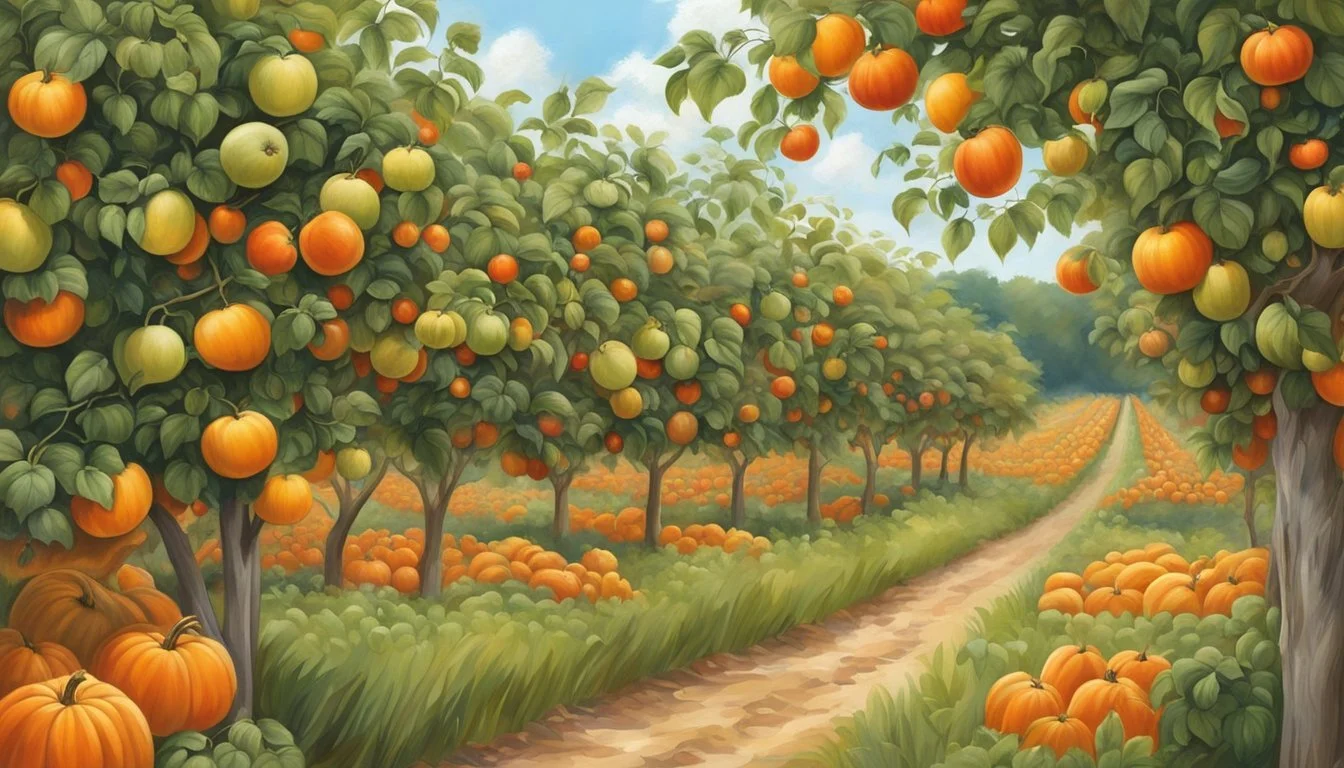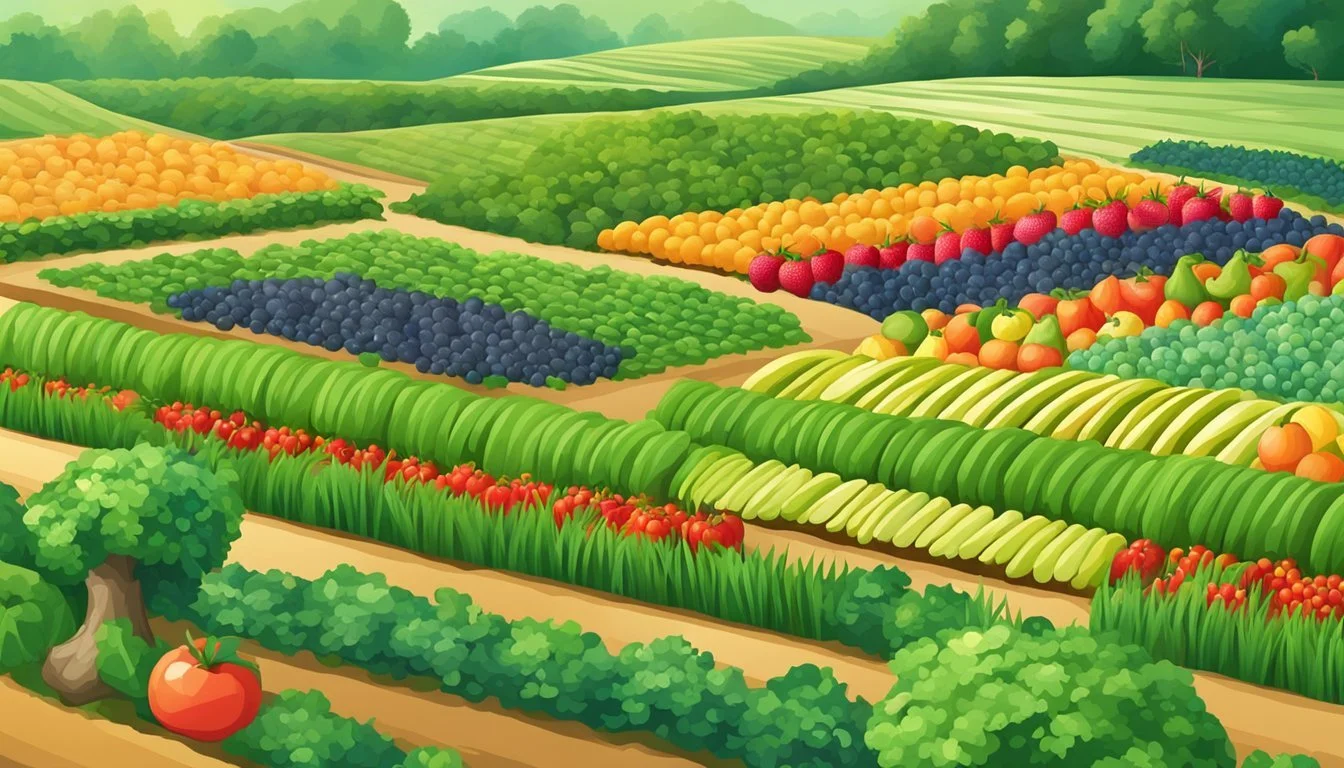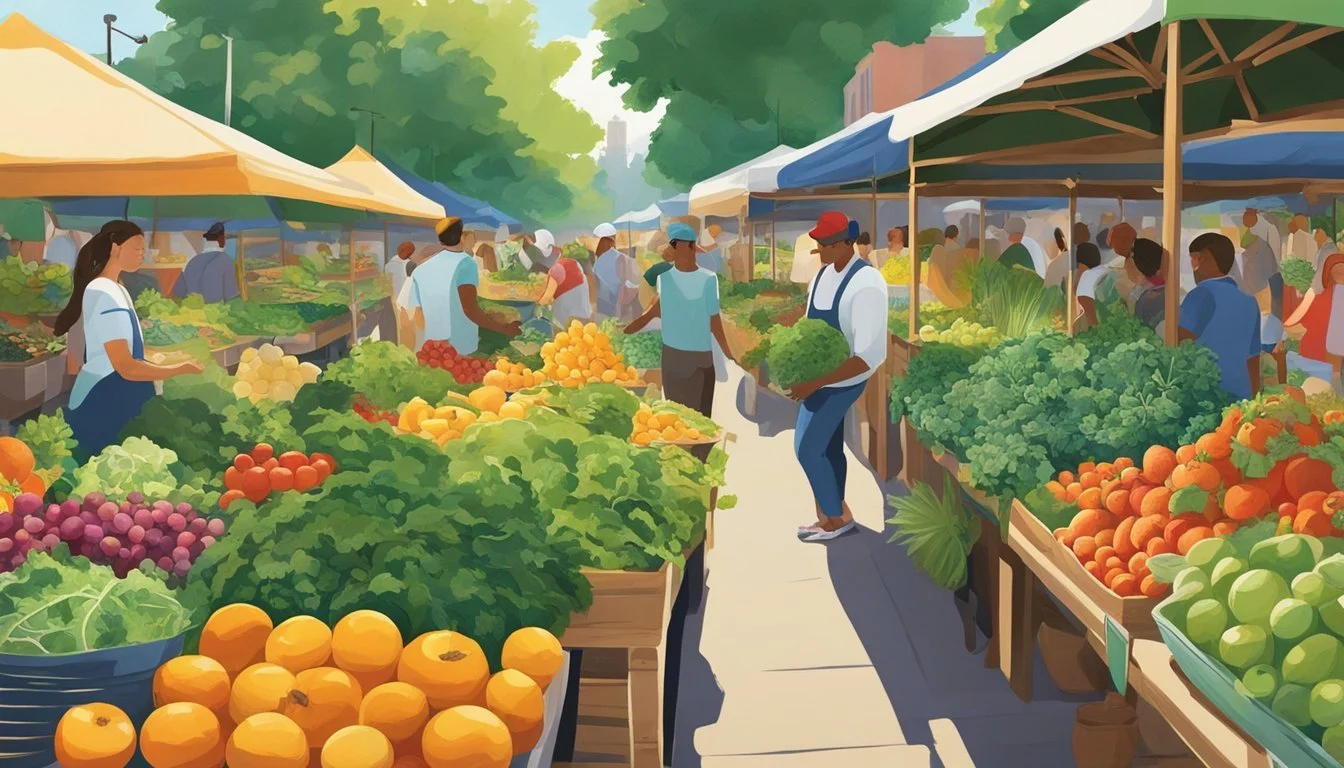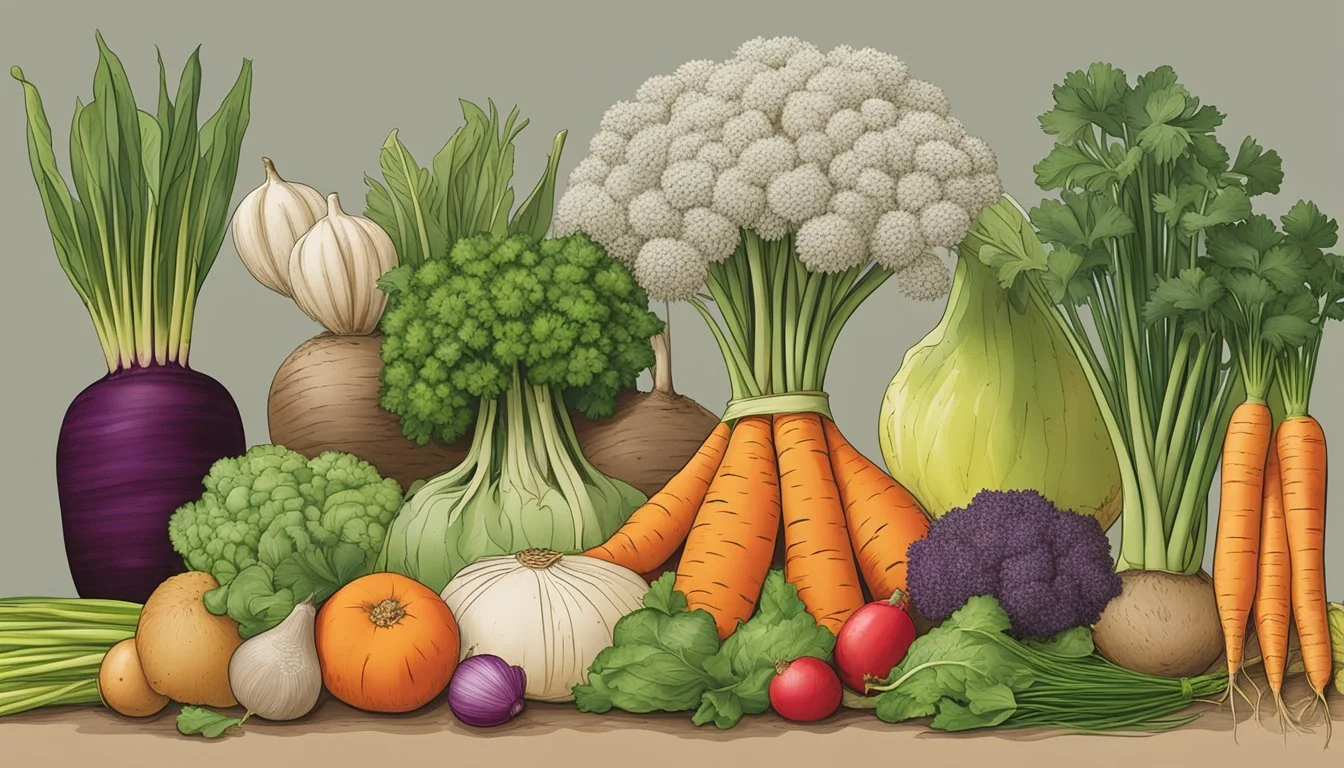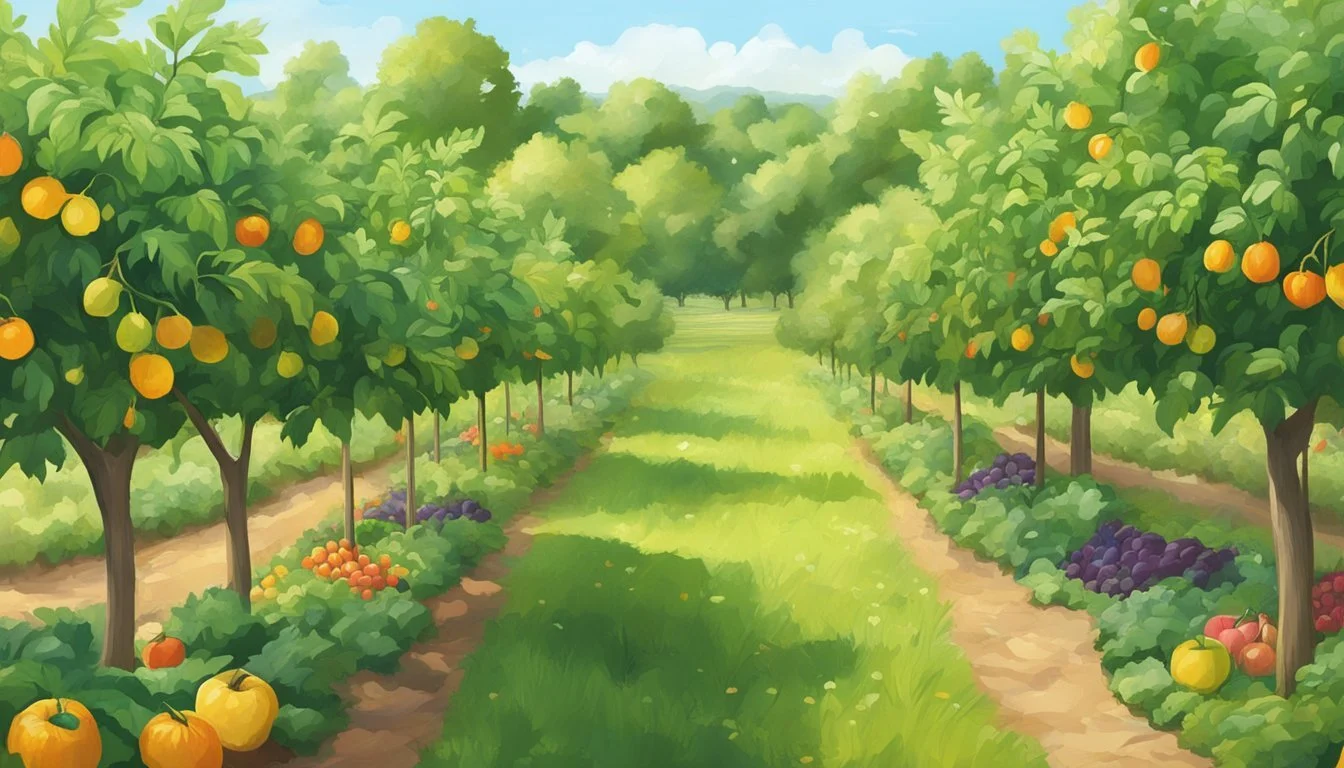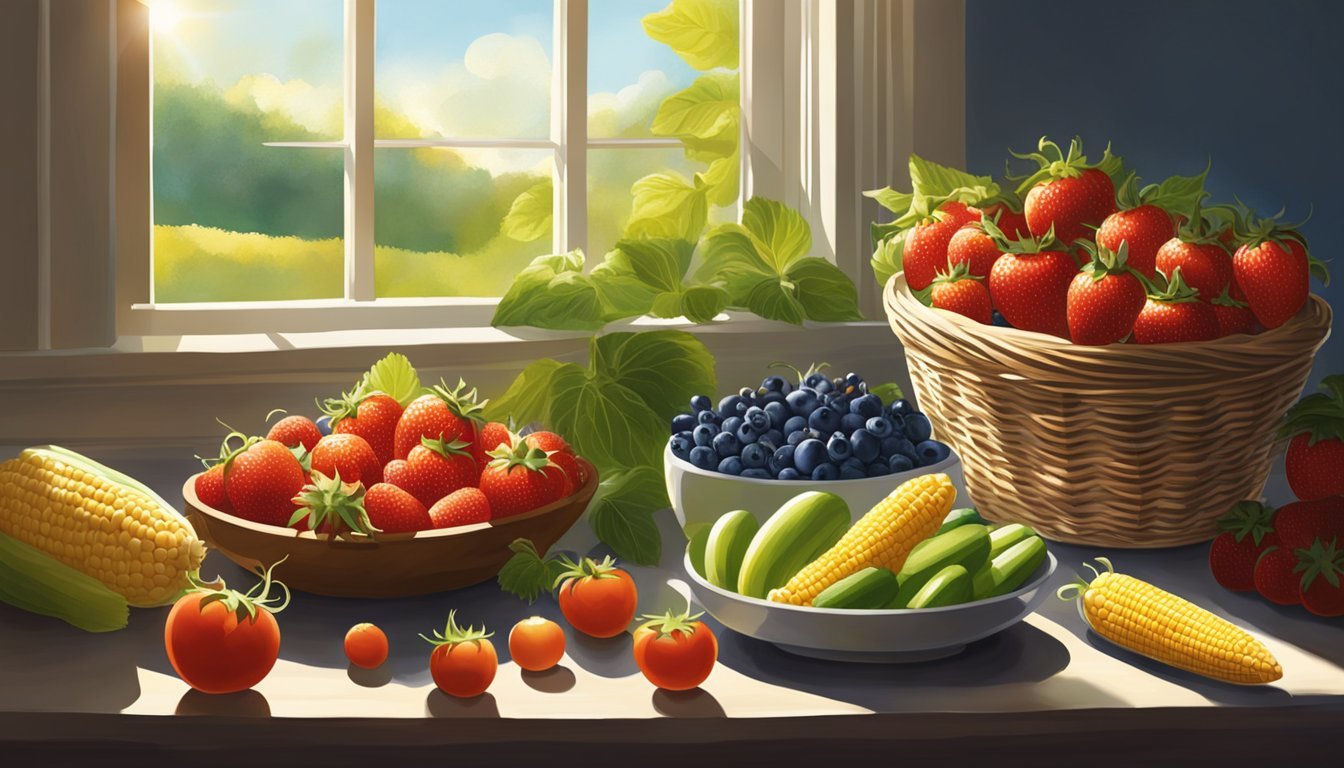Massachusetts Seasonal Fruit & Vegetables in July
A Guide to Fresh Produce
This Article is Part of our Massachusetts Seasonal Fruit & Veg Calendar
During the vibrant summer month of July, Massachusetts boasts a diverse array of fresh fruits and vegetables reaching their peak ripeness. The local farms and markets come alive with the colors and flavors of the season. Residents and visitors alike take advantage of the bountiful produce harvested during these warm weeks. From juicy blueberries to crisp leafy greens, the state's agricultural offerings reflect the rich soil and favorable growing conditions of the region.
July marks a period where the selection of local produce is particularly rich. Blueberries, a staple in New England, are abundant and at their finest, often featured in everything from homemade pies to refreshing summer salads. Alongside them, stone fruits such as peaches and plums also begin to make an appearance, signaling the height of summer sweetness. Vegetable plots offer a plethora of options including zucchini (What wine goes well with zucchini?), summer squash, and cucumbers (how long do cucumbers last?), which become daily staples in the diets of health-conscious locals.
The summer harvest is not only a time of abundance but also a reflection of Massachusetts' dedication to sustainable agriculture and community support. Farmers' markets are a hub for the freshest seasonal produce, providing a connection between the growers and the consumers. The cultivation and consumption of local foods during the peak season are celebrated as a way to enjoy the freshest flavors while supporting the local economy and reducing the ecological footprint.
Overview of Massachusetts' Growing Season
Massachusetts' growing season extends through several months, with July positioned in the heart of summer, marking a period of abundant harvests. Key factors such as climate, soil type, and the length of the growing season influence the types of crops that thrive in the region. Massachusetts experiences a diverse climate, with Plant Hardiness Zones ranging from 5a to 7b, affecting the growing timelines for various produce.
Fruit: By July, the warmer temperatures and longer days have shifted the focus to summer fruits. Residents eagerly anticipate the arrival of berries and stone fruits, with blueberries in particular being a notable harvest during this month.
Vegetables: In the realm of vegetables, the state witnesses a rich variety. Many leafy greens, root vegetables, and flowering plants achieve peak season, providing plentiful options for local consumption and commerce. The following list highlights common crops harvested in July:
Leafy Greens: Spinach, lettuce, and kale
Root Vegetables: Beets, carrots, and radishes
Flowering Plants: Broccoli and cauliflower
Beans & Peas: Green beans and snap peas
Squash: Summer varieties like zucchini and yellow squash
Nightshades: Tomatoes and peppers
In July, the prolonged daylight and typically reliable precipitation contribute to soil conditions conducive to vigorous plant growth. Farmers and gardeners must remain vigilant, however, as this time also presents challenges such as potential droughts or pests that could impact yields. The growing season requires careful planning and adaptation to these environmental factors to ensure a successful harvest.
Primary Fruits in Season
July in Massachusetts is a bountiful month for fruit enthusiasts. With summer in full swing, the region's fertile land yields an abundance of sweet and juicy fruits. Patrons of farmers' markets and local produce stands can indulge in the following peak-season fruits:
Blueberries: Notable for their deep blue hue and high antioxidant content, blueberries are a summer staple. Massachusetts blueberries are ripe and ready for pies, jams, or fresh consumption.
Raspberries: These delicate berries boast a vibrant red color and sweet-tart flavor. Raspberries are perfect for fresh eating or can be used in desserts and sauces.
Strawberries: Though their season often starts in late spring, strawberries can still be found in early July. They are renowned for their bright red appearance and sweetness.
Fruit Description Uses Peaches Juicy and fragrant, with a fuzzy exterior. Pies, cobblers, or eaten fresh. Melons Includes cantaloupes (how long does cantaloupe last?) and honeydews. Fresh salads, desserts, snacks. Cherries Sweet or tart, with a firm texture. Snacking, jams, baked goods.
These fruits not only contribute vibrant colors and refreshing flavors to the summer diet but also provide essential vitamins and nutrients. Buyers will find that local produce is often superior in taste and texture, as the fruits have been allowed to ripen on the vine and are harvested at peak readiness. Supporting local agriculture by purchasing these in-season fruits also benefits the state's economy and promotes sustainable food practices.
Main Vegetables Harvested
In July, the gardens and farms of Massachusetts are brimming with a variety of vegetables at the peak of their freshness. Corn stands out in this month as a staple crop, famed for its sweet kernels that embody the taste of summer. Chefs and home cooks eagerly anticipate the harvest of beans, which include both green and snap varieties, treasured for their versatility in dishes from salads to stir-fries.
Tomatoes, quintessential to the season, reach their prime in July. Their rich red hues and full-bodied flavors enhance any meal, from salads to homemade sauces. Not to be outshone, cucumbers offer a refreshing crunch, making them perfect for salads or as cool, crisp pickles.
The harvest also includes a range of squash, with zucchini being a notable member of this family. Its delicate flavor and tender texture make it an essential ingredient in everything from sautés to breads. Similar in versatility, eggplant (What wine goes well with eggplant?)can be found in abundance, lending its unique taste and meaty texture to a diverse array of culinary creations.
Peppers also take the stage in a spectrum of colors and heat levels. Gardeners and farmers harvest bell peppers for their sweet, mild flavor and chili peppers for that extra kick that spices up any dish.
Vegetable Description Corn Celebrated for its sweetness and summery flavor. Beans Hailed for their versatility in a wide variety of recipes. Tomatoes Known for their rich flavor, ideal for salads and sauces. Cucumbers Crisp and cool, perfect for refreshing summer dishes. Squash Includes zucchini; valued for its delicate flavor and soft texture. Eggplant Appreciated for its robust texture and compatibility with many flavors. Peppers Range from sweet bell peppers to spicy chilis, adding depth to dishes.
Massachusetts's warm July days and cool nights create ideal conditions for these vegetables to develop their flavors and textures to perfection.
Leafy Greens and Herbs Availability
During the warm month of July, Massachusetts offers a variety of leafy greens and herbs that thrive in the summer climate. Gardeners and farmers across the state harvest an abundance of fresh produce during this time.
Spinach generally favors cooler weather; however, certain varieties are still harvested in early July before the summer heat peaks. Kale, on the other hand, is quite resilient and can be found in abundance throughout the month. Known for its hearty leaves, kale can withstand summer warmth, providing a continuous yield.
Swiss Chard is another leafy green that is readily available in July. This versatile vegetable can be used in a myriad of dishes, ranging from sautés to salads.
As for lettuce, several types flourish during this season. The following varieties are commonly available:
Romaine: Crisp and hearty, perfect for Caesar salads.
Butterhead: Known for its tender leaves and sweet flavor.
Green Leaf: Offers a mild taste and a ruffled appearance that adds texture to dishes.
In the herb section, July sees an ample supply of Basil, a favorite among culinary enthusiasts for its fragrant and sweet flavor with hints of anise. Parsley, both curly and flat-leaf types, is also plentiful, offering a fresh, clean taste to a myriad of recipes.
Thyme and Mint are robust herbs that thrive well in the heat. Thyme brings a subtle earthiness to dishes, whereas mint adds a refreshing coolness, making it a summer staple.
Farmers' markets and local gardens in Massachusetts showcase these leafy greens and herbs, highlighting the season's best offerings with freshness and quality.
Root Vegetables and Alliums Selection
In Massachusetts, July marks a bountiful season for a variety of root vegetables and alliums. Shoppers can expect to find beets, carrots, and radishes at their peak freshness in local markets. Each of these root vegetables offers unique flavors and nutritional benefits. Beets provide a rich, earthy taste and are excellent for roasting or boiling. Carrots, known for their crisp texture and sweetness, are versatile for both raw and cooked dishes. Radishes, with their peppery bite, are perfect for adding a crunchy element to salads.
As for alliums, onions, garlic, and leeks are available in abundance. The Massachusetts July harvest allows these alliums to burst with flavor, enhancing a myriad of recipes. Onions and garlic are kitchen staples with wide use in cuisines due to their profound flavor profiles that deepen with cooking. Leeks, slightly milder and sweeter, are ideal for adding a subtle onion-like essence to dishes.
Here is a quick format to show when these vegetables are typically in season:
Vegetable Season in Massachusetts Beets June - October Carrots June - November Radishes June - September Onions July - October Garlic July - August Leeks July - October
Shoppers are encouraged to explore these local, seasonal offerings. Root vegetables can be stored for extended periods, and alliums often form the base for savory stock and soups, as well as providing foundational flavors for a range of dishes. As they visit farmers' markets and local grocers, individuals have the opportunity to support local agriculture and enjoy the freshest produce available.
Orchard Fruits and Other Delicacies
In July, Massachusetts orchards are abundant with a variety of fruits, each bursting with flavor and ready for harvest. Among these, nectarines stand out for their smooth skin and sweet taste. They are perfect for eating fresh or for incorporating into summer desserts.
Plums, with their juicy flesh, offer a sweet yet slightly tart flavor. These fruits are versatile, used fresh, in baked goods, or even preserved. Their vibrant colors range from deep purples to reddish hues, and they are known to be rich in antioxidants.
Blackberries (how long do blackberries last?) come into season as well. These berries are not only succulent and packed with vitamins but also ideal for jams, jellies, and summer pies. Their dark, glossy clusters are a common sight at local markets and are a favorite among residents for their balance of sweetness and a hint of tartness.
Below is a brief summary of each of these fruits:
Fruit Description Nectarines Smooth-skin relative of the peach, known for its sweet and succulent taste. Plums Juicy stone fruit with a sweet and tart flavor, used in various culinary preparations. Blackberries Dark, glossy berries, known for their sweet and slightly tart flavor, rich in vitamins and fiber.
Consumers and chefs alike highly seek these delicacies for their freshness and quality during the Massachusetts summer. Each offers unique flavors and health benefits that contribute to the region's diverse produce offerings. Visitors are encouraged to experience these flavors first-hand at local farmers' markets, orchards, and through pick-your-own fruit farm activities.
Preparing Seasonal Produce
In July, Massachusetts offers an abundance of fresh, ripe produce. This section provides practical advice on how to handle and make the most of the local bounty.
Cooking Suggestions
Massachusetts' July harvest presents a plethora of options for cooking. Ripe berries can be transformed into desserts such as pies and cobblers, or simply enjoyed fresh. Leafy greens, zucchini, and cucumbers are perfect for salads. For a savory course, corn and tomatoes can be baked into casseroles or accompanied with herbs and butter for a delightful side dish.
Desserts: Use berries and stone fruits for pies, tarts, and crisps.
Salads: Incorporate fresh greens, cucumbers, and tomatoes.
Baked: Try zucchini bread or roasted corn (how long does roasted corn last?) with herbs.
Storage and Preservation Tips
To extend the enjoyment of July's produce, proper storage and preservation methods are key. Berries should be kept in a refrigerator and eaten within a few days. Most vegetables will last longer when stored in a cool, dry place or refrigerated. Cucumbers and zucchini can be pickled, and herbs can be dried or frozen in olive oil.
Refrigerate: Berries, leafy greens, and fresh corn.
Dry or freeze: Herbs for long-term use.
Farm Stand Varieties
Local farm stands offer a variety of fresh, local produce. One can find heirloom tomato varieties, different types of summer squash, and freshly picked berries. These farm-fresh items are often at their peak of ripeness, providing superior flavor and quality compared to non-local options.
Find at Farm Stands: Heirloom tomatoes, summer squash, fresh berries.
Health Benefits of Seasonal Eating
Eating seasonally ensures that produce is at its peak nutritional value. Fresh, local produce often retains more nutrients because it is consumed closer to the harvest date. Seasonal eating also supports a diversified diet that can lead to better health outcomes.
Benefits: Higher nutrient content, support for local agriculture.



